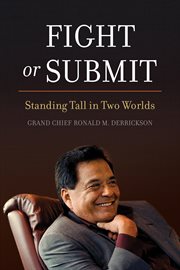Nonfiction
eBook
Details
PUBLISHED
Made available through hoopla
DESCRIPTION
1 online resource
ISBN/ISSN
LANGUAGE
NOTES
In the opening to his memoir, Grand Chief Ron Derrickson says his "story is not a litany of complaints but a list of battles" that he has fought. And he promises he will not be overly pious in his telling of them. "As a businessman," he writes, "I like to give the straight goods." In Fight or Submit, Derrickson delivers on his promise and it turns out he has a hell of a story to tell. Born and raised in a tarpaper shack, he went on to become one of the most successful Indigenous businessmen in Canada. As a political leader, he served as Chief of the Westbank First Nation for a dozen years and was made a Grand Chief by the Union of British Columbia Indian Chiefs. Along the way, he has been the target of a full Royal Commission and an assassination attempt by a hitman hired by local whites. As Chief, he increased his community's revenues by 3500% and led his people into a war in the forest over logging rights. In 2015, he became an award-winning author when Unsettling Canada: A National Wake-Up Call, a book he co-authored with Arthur Manuel, won the Canadian History Association Literary Award. His second book co-authored with Manuel, Reconciliation Manifesto, won the B.C. Book Prize for non-fiction. Grand Chief Derrickson is one of the most successful Indigenous entrepreneurs in Canada and used his business experience to lift his community out of poverty, making it one of the wealthiest bands in the country. He tells of how he's always tried to do the right thing in the face of hatred and violence. Grand Chief Ronald M. Derrickson is one of the most successful Indigenous entrepreneurs in Canada. He also served as Chief of the Westbank First Nation for a dozen years and led his community from poverty to prosperity while surviving an assassination attempt and a Royal Commission on his business and political activities. He lives in Westbank First Nation, close to Kelowna, B.C. The flight from Kiev, where I have business interests, to my community in the interior of British Columbia is close to 12,000 kms. With stops in Amsterdam and Calgary, it takes 26 hours from the time my driver, Volodya, picks me up my flat near Bessarabska Square and I arrive at my Westbank office in the British Columbia interior. It is a flight I take back and forth several times a year, often after several months-long stays. But each time I arrive on the last leg of the trip from Calgary to Kelowna, I feel a surge of energy as we pass over the towering peaks of the outer Rockies and begin our descent onto the interior plateau where my Okanagan people have lived since time immemorial. My Indigenous territory is part of me. It belongs to me and I belong to it. Or rather, what's left of it. The airport is on the other end of town, so while we chat, we pass through the heart of the city where my great grandfather once owned a major part of the downtown area before he was cheated out of it by locals working with a corrupt magistrate. The Westbank reserve is on the west side of the W.A.C. Bennett Bridge spanning the narrow section of Lake Okanagan. It is one of a few tiny pieces of the once vast Okanagan territory that remains under our control. I was born and grew up in a shack without plumbing or electricity on the hills overlooking the lake. My earliest memories are of kneeling in the field, gathering vegetables alongside my mother. And, when I was older, riding our horses along the ridge with my brother Noll. As a young man, I ranched these lands and for more than a dozen years, in the 1970s and 1980s and again at the turn of the century, I was Chief of the Westbank First Nation. Both sides of the road cutting through the reserve are now crowded with stores and businesses on leased reserve lands in deals I negotiated to bring income into what was once the poorest reserve in Canada
Mode of access: World Wide Web







